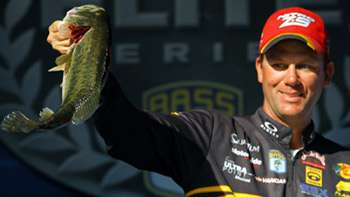
This two-part series will take a close look at one of the hottest baits on the market, Strike King’s Red Eye Shad. In Part I we’ll detail how this bait was conceived and developed. In Part II Kevin VanDam will tell us how to catch fish with it.
Developed by Strike King and Elite Series pro Kevin VanDam, the Red Eye Shad has taken the fishing community by storm. Anglers from New England to Florida, and as far west as California, are filling their livewells with bass that have fallen for its alluring action and unusual colors.
But don’t think for a minute this bait was developed by accident, or that it was a lucky stroke of genius. It wasn’t. It’s the product of many months of testing and development across four states, both on and off the water.
“Once we started with the design process, it took us about 30 months before we got it right,” says Phil Marks, New Products Manager for Strike King. “It wasn’t an easy bait to develop. There’s a lot of engineering and testing behind this lure.”
The process started with Kevin VanDam. He wanted a lipless crankbait that was different than any other on the market, a new and improved model. His list of suggested improvements was long.
First on that list was the fall. VanDam was looking for something that held its attitude in the water and then shimmied a bit as it fell after being stopped. He wanted to avoid the “potato chip” look that other lipless crankbaits acquire as they fall.
Basically, Marks and VanDam used three rattles to achieve that result. They employed high weight to create wobble and flash as the lure is being cranked through the water. Belly weight keeps the center of gravity below the midpoint of the lure. This allows it to fall properly.
And finally, the nose weight stabilizes the bait. This forces it to track straight during the retrieve, regardless of speed.
“They all work together to make the Red Eye Shad what it is,” explains Marks. “It took us forever to get everything right. When you change one weight it changes the effect of the others. It was like playing three dimensional checkers. Nothing was simple about it.
“Everything has to work together to give it that unique shimmy as it falls. If anything is wrong, it doesn’t look right. And, if it doesn’t look right to us it won’t look right to the fish.”
Add to those issues the fact that plastic density, air chamber size and the physical shape of the lure body play an important part in this, too. If any of those things change, the effect of the weights change.
“Basically it was a six part deal — three weight locations, plastic density, the size of the air chambers and the physical shape of the body,” Marks summarizes. “This was one of — if not the — toughest and most complex fishing lure projects I’ve ever worked on.”
There were other things VanDam wanted, too. The lure had to run true out of the box, cast well, be durable, and not rattle too loud.
“There’s no telling how many prototypes we put together. And every time we’d get one together Kevin would fish with it and then want something different, something better. This guy never runs out of energy, and good is never good enough. He’s a perfectionist, and sometimes a borderline pain in the butt,” Marks laughs. “But the results speak for themselves.”
Once they had the bait physically right, it was time to work on the color schemes. Again, VanDam was an integral part of the process, from start to finish.
“He’s real big on shades and subtle variations in color. For some waters he wants a naturally colored bait the fish can’t see until it’s right on top of them. But for other water colors he’s looking for bright, easily visible colors. It’s a very precise process with this man.
“He came to the shop and worked in the paint room for many hours. When all was said and done there were 17 prototype colors with his name on them. Six of them are in production now, one is the Sexy Shad,” Marks says with a note of finality.As of this writing Red Eye Shads are only available in a 1/2-ounce size.
A 3/4-ounce version has been developed. It meets VanDam’s standards and is in production at this time. It should be in your local tackle shop by July or August.
A 1/4-ounce size is in the design stage. “We’re having some trouble getting it right,” Marks explains. “It’s been more difficult to engineer than we first thought, and Strike King doesn’t release anything until it’s right, period.”




